Physical Description
Echinometra mathaei are roughly spherical in shape and exhibit pentamourous symmetry. The urchin consists of the main body known as the test, and is surrounded by spines extending outwards in all directions. Spines on the ventral (oral) surface of the urchin are smaller in size and are parted in the centre where the feeding appendage occurs, and spines are similarly smaller on the aboral surface where they give way to the anus.
Size
Adult E.Mathaei can grow to sizes of up to 85mm diameter, with no sexual dimorphism (McClanahan and Muthiga, 2007). Most specimens are between 30 and 70mm diameter with a test size of up to 50mm. Spines can reach lengths of up to 20mm.
Colour
The test of E. mathaei is a dark maroon to dark brown colour. Spine colour varies with individuals showing spines of various shades of green, grey and purple. Spine colour may vary along the length of spine, with some spines appearing pale purple at the base and turning darker towards the tip, or green along the length with white tips.

Figure 1. Echinometra mathaei with pale banding around the base of spines.
Identification
E.Mathaei can be distinguished from other urchin species by the pale ring at the base of each spine, a unique characteristic of the species(Boyer, 2012).
Identification resources:
http://eol.org/pages/599665/overview
http://www.marinespecies.org/echinoidea/aphia.php?p=taxdetails&id=213383
|